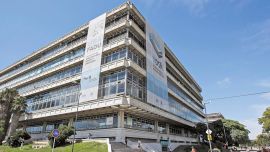Last December, the Buenos Aires City Legislature brought in a new set of regulations to govern urban development in the nation’s capital, replacing legislation that dated back to 1977.
The introduction of the new rules was barely noticed, lost in the midst of more urgent political issues. Yet the tenets contained within the City government’s new Urban Planning Code (or Código Urbanístico, in Spanish) are likely to have a major, long-lasting impact on the lives of many porteños.
The government of Mayor Horacio Rodríguez Larreta said its goal in forming the code was to alter the capital’s traditional approach of dividing the city into zones with mixed-use areas, instead favouring a development model with relatively high densities.
On its face the project appears to be a good idea, but critics say the new approach fails to address some of the main urban problems of the country’s capital.
NEED FOR CHANGE
Over the last few decades, the urban planning regulations for the City of Buenos Aires were laid down in the Código de Planeamiento Urbano, legislation which was passed during the last military dictatorship (1976- 1983), though minor changes were made to the code in 1989 and 2000.
Following the teachings of the modernist movement, city-planners favoured zoning (dividing the city into zones — residential, industrial — in which certain land uses were permitted or prohibited) and envisioned a city dominated by motorways, generating a development heavily reliant upon private cars and transport. The most noticeable result of this era was the spread of the high-rise building, the famous “towers” (or torres) that were erected throughout Buenos Aires in both commercial and residential areas.
At first this took the shape of a real-estate boom in the Catalinas Norte area near Retiro station, but then in the 1990s and 2000s that gave way to a frenzy of modern residential towers in Palermo, Caballito and other neighbourhoods. With 467 buildings over 12 stories high, today Buenos Aires is one of the cities with most high-rise buildings in all of South America, second only to São Paulo.
These developments, however, went against the latest, emerging trends in urban development, where the keywords were ‘human-scale,’ ‘sustainability’ and ‘identity.’ Even when the City administrations of Mauricio Macri (2007-2015) and Rodríguez Larreta (since 2015) began to implement some modest projects that incorporated the principles of so-called ‘New Urbanism’ thought (such as bike lanes, the creation of pedestrian-only streets downtown) it was clear that these measures were being adopted without any major changes to regulations that encouraged the use of the motor car and invited developers to tear down the existing buildings and build new, higher structures with little regard of how uneven some urban blocks in City would appear.
OVERHAUL
With the goal of overhauling this decades-old system, the Buenos Aires City government embarked on a path to introduce new rules. After two years of discussions, the local legislature eventually passed a new Urban Planning Code with votes entirely from Rodríguez Larreta’s Vamos Juntos coalition.
Some of the main aspects of the new regulations include allowing mixed uses in several districts (as opposed to those much-criticised zoning laws of the past), streamlined and updated rules for the height of buildings and a call to complete “the urban tissue” — a reference to attempts to ensure that population growth be focused in existing built-up areas, in an effort to tackle urban sprawl.
The enacting of these regulations were completed with the approval of a separate law, the Ley de Plusvalía Urbana, which would capture urban capital gains from those developers who take advantage of additional construction capacities. More concretely: a tax that will depend on the amount of additional square metres allowed by the new regulations that the
City government would use to fund infrastructure works and urban mobility policies. City government officials say these changes were essential.
“We needed a law that provided urban and environmental regulations for the 21st first century and that oriented the growth of the city to avoid the widening of the urban space,” City Planning Undersecretary Carlos Colombo told the Times.
However, not everyone shares his optimism.
“We knew some kind of reform was long overdue, but we don’t agree with its main aspects,” said Jonatan Baldiviezo, a lawyer and president of the Observatorio del Derecho a la Ciudad NGO, who has reservations about the new code.
He says the City authorities’ priorities are not the same as those of most porteños.
“For the government, the city’s main problems were ‘uneven’ street corners and bare walls separating buildings, while for us the main issues are the housing crisis, the collapse of public services and the lack of green spaces,” he told the Times.
While the population of the capital had remained steady at around three million since the 1950s, City government officials have expressed previously that they want twice that many people living within the city limits, arguing the new code was written with that goal in mind.
Baldiviezo, however, argued the new regulations does not prepare for such a new scenario — apart from allowing more square meters to be built in each lot, that is.
“The new regulation has no plan on how or where to build enough schools, hospitals or adequate municipal infrastructure and utility services for six million people,” the lawyer said.
REACHING NEW HEIGHTS
Not every change has been greeted with scepticism though. One of the main innovations of the new urban planning rules is a much simplified table, indicating allowable height and building areas. On major avenues,such as Corrientes or Del Libertador, buildings will be limited to 12 storeys high; along other wide roads, the limit is set between six and nine storeys, while in regular streets buildings won’t be able to exceed 16.5 metres (some four storeys).
These were all welcome changes in light of the complex rules laid down in the previous code, where practically everything regarding high-rise towers in residential areas was up to interpretation. In fact, over the last few years the City’s Office of Urban Interpretation (DGIUR, in its Spanish acronym) has been accused of being too “generous” in its rulings, with critics saying it repeatedly found new reasons to allow the construction of high-end residential sites in the heart of traditional neighbourhoods such as Palermo or Caballito.
“This Urban Planning Code puts things in order for small plots throughout the city,” said urban specialist Marcelo Corti, the editor-in-chief of the digital magazine Café de las Ciudades. “However, several large pieces of land remain labelled as ‘special urban areas’ (Urbanizaciones Especiales), which means there is no decision yet on what to do with them.”
Many of these vacant lands belong to the federal government and others to the City of Buenos Aires, Planning Undersecretary Colombo confirmed.
Some of these large areas set aside for later classification are, precisely, ones being auctioned off by City Hall to private companies.
A report published earlier this month by the Professional Council of Architecture and Urbanism (CPAU) revealed that between 2017 and 2019, the national government of Mauricio Macri and the local City administration of Horacio Rodríguez Larreta sold off state land in Buenos Aires City for a total of US$953.7 million. The sell-off included public lands such as the Tiro Federal shooting range in Núñez, a railyard in Colegiales and the El Dorrego fairgrounds.
THE UNDERLYING QUESTION
Attention of late has also turned to what’s missing from the new code. Some experts believe its main shortcoming is that it evades debate about the role of the State in urban planning.
“The new code limits itself to regulating private space, without setting clear parameters to guide the renewal, rehabilitation and preservation of public spaces,” architects at CPAU said in a recent document. “The rules that shape the urban form are healthy regulations that acknowledge the need to work with the city’s already-built area, but the equation between density, transport and infrastructure remains unsolved.” According to the organisation, the new code lacks a “metropolitan vision” that addresses challenges of transportation and the environment, especially in the Greater Buenos Aires area, which is home to 15 million people.
“The City of Buenos Aires should be discussing its model of development from the point of view of its public institutions like Housing and Urban Development,” Corti argued, pointing to what he believes to be an ideological bias against direct state investment in the area. “But putting public land to public use, favouring the middle and working classes, has been done in Medellín, Singapore and even the Urban Development Zones of France.”
And here lies the heart of the matter. The housing deficit in the capital continues to worsen: porteños now need five monthly salaries to afford just one square metre of property (imagine workers earning an average salary of 25,800 pesos or US$570 trying to buy a two-room apartment that can cost US$143,000). Credit for housing is virtually non-existent, and only a privileged few can buy. The trend is clear: 54 percent of all new building permits issued last year were for luxury homes.
The new code orders and simplifies rules for building in the City, and that’s no doubt a positive step forward. But it does little to address externalities outside the market. A more streamlined skyline perhaps, but with the same unequal development: something of a missed opportunity for Buenos Aires.


























Comments